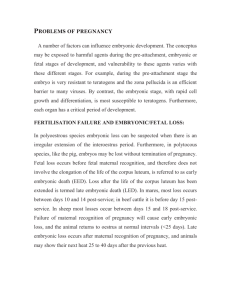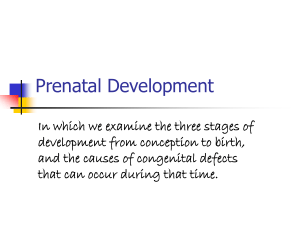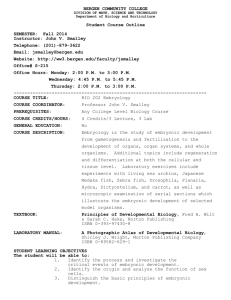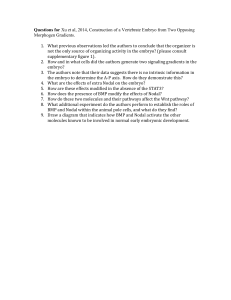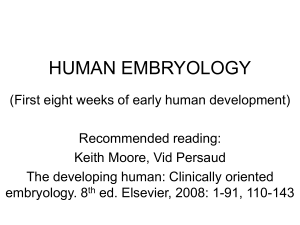Problems of pregnancy
advertisement
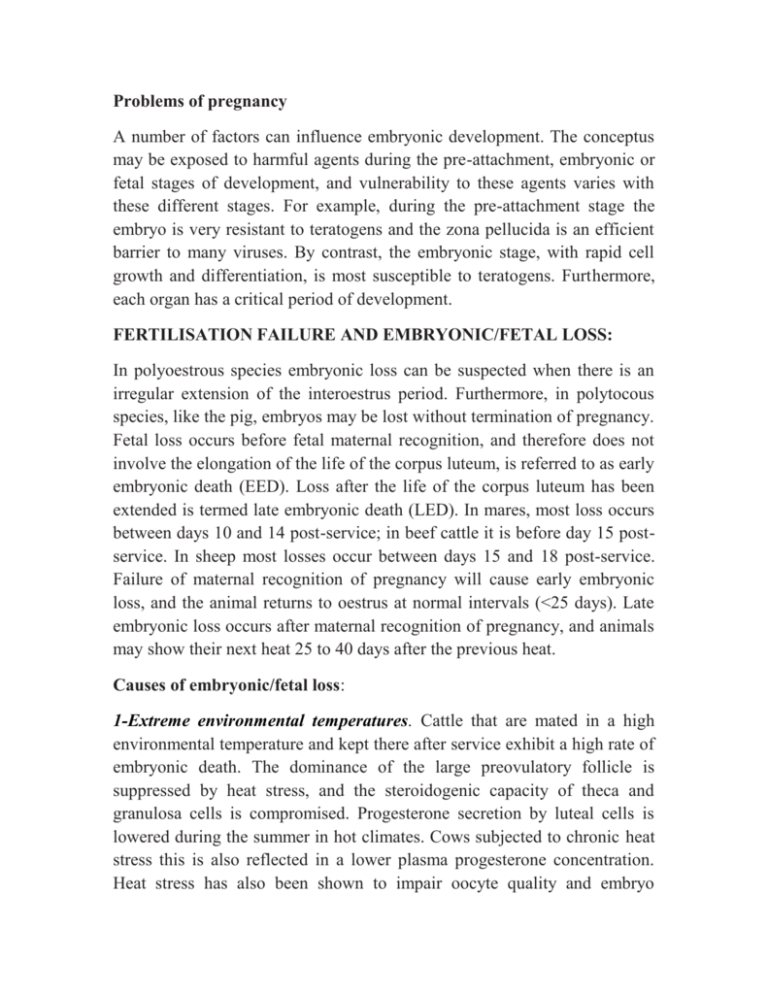
Problems of pregnancy A number of factors can influence embryonic development. The conceptus may be exposed to harmful agents during the pre-attachment, embryonic or fetal stages of development, and vulnerability to these agents varies with these different stages. For example, during the pre-attachment stage the embryo is very resistant to teratogens and the zona pellucida is an efficient barrier to many viruses. By contrast, the embryonic stage, with rapid cell growth and differentiation, is most susceptible to teratogens. Furthermore, each organ has a critical period of development. FERTILISATION FAILURE AND EMBRYONIC/FETAL LOSS: In polyoestrous species embryonic loss can be suspected when there is an irregular extension of the interoestrus period. Furthermore, in polytocous species, like the pig, embryos may be lost without termination of pregnancy. Fetal loss occurs before fetal maternal recognition, and therefore does not involve the elongation of the life of the corpus luteum, is referred to as early embryonic death (EED). Loss after the life of the corpus luteum has been extended is termed late embryonic death (LED). In mares, most loss occurs between days 10 and 14 post-service; in beef cattle it is before day 15 postservice. In sheep most losses occur between days 15 and 18 post-service. Failure of maternal recognition of pregnancy will cause early embryonic loss, and the animal returns to oestrus at normal intervals (<25 days). Late embryonic loss occurs after maternal recognition of pregnancy, and animals may show their next heat 25 to 40 days after the previous heat. Causes of embryonic/fetal loss: 1-Extreme environmental temperatures. Cattle that are mated in a high environmental temperature and kept there after service exhibit a high rate of embryonic death. The dominance of the large preovulatory follicle is suppressed by heat stress, and the steroidogenic capacity of theca and granulosa cells is compromised. Progesterone secretion by luteal cells is lowered during the summer in hot climates. Cows subjected to chronic heat stress this is also reflected in a lower plasma progesterone concentration. Heat stress has also been shown to impair oocyte quality and embryo development, and increase embryo mortality. In addition to the immediate effects of heat stress, delayed effects have also been detected. These include altered follicular dynamics, suppressed production of follicular steroids and lower quality of oocytes and developing embryos. This may explain why poor fertility may persist for some time after periods of heat stress. Poor pregnancy rate is a problem when European cattle are introduced into hot countries where they are exposed to ambient temperatures above 30°C; it is quite likely that increased embryonic death is part of the reason. There is little doubt that genetic factors are involved in this as in other aspects of heat tolerance. Crosses between indigenous heat tolerant breeds and European breeds are more heat tolerant than the imported animals and they are more fertile. The improved fertility appears to be the result of the dam’s enhanced ability to control body temperature rather than an inherited ability of the embryo itself to tolerate high intrauterine temperatures. The position is less clear with extreme cold, but there are indications that a corresponding adverse effect occurs. The problem could arise during unusually cold periods in temperate climates where housing tends to provide cover rather than warmth. 2-Metritis/endometritis: Metritis or endometritis in varying degrees of intensity is a common condition causing infertility in cattle. Where caused by infection it can be divided into non-specific, exemplified by Arcanobacterium pyogenes infection, and specific, typified by Tritrichomonas fetus and Campylobacter fetus infection. There are also a number of infections that are difficult to classify such as bovine herpes virus-1 (BHV-1), Ureaplasma spp. and Haemophilus somnus. Non-specific metritis is the result of either massive infection or of the infective organisms taking advantage of a deficient uterine defence mechanism, usually caused by damage at and after calving. Non-specific infection can be facilitated by the synergistic action of different organisms, for example A. pyogenes and Fusobacterium necrophorum. Specific infections colonize the undamaged uterus. Two important specific infective agents are C. fetus and T. fetus. Campylobacteriosis is spread venereally and causes a mild endometritis in infected females that have not had previous experience of the condition. It has been shown in slaughter experiments that in infected animals fertilization rate is normal and that the infertility is due in the main to embryonic death within three weeks of conception. Loss of the embryo is likely to be due to interference with the uterine environment. Another infectious agent that is introduced from the vagina into the uterus at insemination, but not at natural service, is Ureaplasma, which causes a purulent metritis and infertility. Haemophilus/Histophilus also causes vaginitis and reduced fertility. For detailed discussion of a wide range of infectious agents. Infectious conditions can cause infertility in at least four ways: 1-The febrile reaction raises the temperature of the uterus. Bluetongue is an example of a disease that causes a high temperature resulting in loss of the embryo at about the time of hatching from the zona pellucida, about day 10– 12 after service. 2- The organism infects the uterus and causes metritis, which presumably interferes with embryo nutrition and may also infect the embryo. Examples are BHV-1 virus and Chlamydiales infections. It is likely that, in general, mild endometritis causes embryonic death whereas in cases of purulent metritis there may be interference with spermatozoa survival and thus fertilization failure. 3-Infection of the conceptus can cause its death. The thought that embryo transfer could transmit infectious diseases from the sire or the dam is worrying. In theory, bacterial and fungal infections are less likely than viral infections to be carried by embryos. From experimental studies with many different viruses it appears that if the zona pellucida is intact and the embryo is washed properly, there is little danger of the transmission of viral infections by embryo transfer. However, the advent of in vitro technology may increase the risk of disease transmission due to differences in the zona pellucida of in vitro derived embryos, enabling easier adsorption of pathogens, and due to the use of biological products for culture which may be contaminated with pathogens. 4-Endotoxins produced by Gram-negative infections can increase PGF2a production and cause premature luteolysis. 3-Maternal endocrine environment: low plasma concentrations of progesterone resulted in the development of a stronger luteolytic signal. This was taken as an explanation for the fact that cows with lower plasma concentrations of progesterone post insemination are more prone to embryo loss than those with higher progesterone levels. Interferon tau (IFN-t) is a protein produced by the embryo that acts locally within the uterus to block luteolysis and maintain the corpus luteum; it prevents PGF2a secretion by inhibiting the development of oxytocin receptors in the endometrium. Successful maternal recognition of pregnancy in cows depends on the presence of a sufficiently well developed embryo producing sufficient quantities of IFN-t, which is, in turn, dependent on an appropriate pattern of maternal progesterone secretion. the maternal endocrine environment, and particularly maternal progesterone levels within the first one to two weeks after insemination, is likely to be extremely important in determining whether an embryo signals its presence to the dam and survives or is lost as the cow returns to oestrus. 4-Aged gametes: Fresh chilled semen ages after several days and the inseminated cows have a lower pregnancy rate almost certainly due to both reduced fertilization rate and increased loss of embryos. There is no evidence of adverse effects from ageing of frozen semen stored in liquid nitrogen. Fertilization of ageing eggs following ovulation of persistent dominant follicles is also likely to result in an increased amount of early embryonic death. 5-Local trauma: This cause of loss affects the late embryo and early fetus. One source of local trauma to the pregnant uterus is the hand of a person carrying out manual pregnancy diagnosis, or some other palpation of the uterus. In one study the average loss was 2.82 per cent of cows diagnosed pregnant. Fetal loss rate of 9.5 per cent in cows diagnosed pregnant on days 42–46. The technique, which was carried out on two days, involved palpation of fetal fluid, identification of the amniotic vesicle and slipping of the chorioallantoic membranes. However, with good transrectal ultrasound examination technique such losses should now be largely preventable. 6- Genetic factors: In some cattle, in the process of cell division, translocation of parts of certain chromosomes without loss of genetic material has taken place, a condition that is passed on to future generations. These individuals can be identified by cytogenetic examination of leukocytes. When semen from bulls with a translocation is used for insemination there is a slight increase in the incidence of return to service, which is believed to be the result of embryonic death, presumably because of lack or excess of some genetic material due to abnormal division at meiosis. It is also probable that many genetically abnormal embryos are lost early in development, with the advantage that the dam can return to normal breeding at the earliest opportunity. Some factors almost certainly cause an increased return to service via an unknown mechanism. An example is the etiological relationship between loss in body condition from calving to service and associated poor pregnancy rate. The possible sites where inadequate nutrition may have detrimental effects on reproductive function include: 1- The hypothalamus/pituitary gland to impair gonadotrophin release. 2 -The ovaries, possibly resulting in altered follicular growth patterns and reduced quality of oocytes and subsequent reduced embryo survival. 3 -Inadequate uterine environment resulting in impaired embryo survival. Genetic factors causing embryonic loss include single-gene defects, polygenic abnormalities and chromosomal anomalies. A few single-gene mutations are lethal and result in the death of the conceptus. If the gene is dominant, a single copy may be sufficient to cause death, whilst in other instances it is only the homozygous state that is lethal (e.g. the dominant Manx gene (M) in the cat). Recessive genes only exert their effect in the homozygous state. Not all genetic defects are lethal. Some abnormal fetuses survive to term, which is biologically and economically wasteful. Therefore, carrier animals should be eliminated from the breeding programme wherever possible. Traditional methods of test mating to identify animals which are carriers of a recessive gene (backcross to the recessive) are laborious and in some cases not justified on welfare grounds. The mule is a cross between a female horse and a male donkey, and the hinnies are a cross between a female donkey and a male horse. The males of both crosses show abnormalities of chromosome pairing at the pachytene stage of meiotic prophase, and little or no mature spermatozoa are produced. Thus the males are infertile. Females are also affected during the fetal development of the germ cells, and most oogonia die as they are entering meiosis. However, sometimes a mature follicle is present in the adult, and, rarely, confirmed foalings have been reported in both mules and hinnies.
